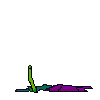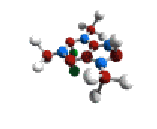|
|
!!!Welcome !!! |
|
||||||||||||||
 |
 In early 1994, linkage studies placed the achondroplasia gene on the short arm of human chromosome 4, distal to an anonymous marker, D4S43. This region on chromosome 4 had been scrutinized for more than 10 years by scientists searching for the Huntington's disease gene, and among the genes already known to reside in this area was fibroblast growth factor receptor 3 (FGFR3). Proteins in the family of fibroblast growth factor receptors have a highly conserved structure. The protein spans the cell membrane and consists of three extracellular immunoglobulin-like domains, a lipophilic transmembrane domain, and intracellular tyrosine kinase domains. FGFR3 is expressed in cartilage and brain, and the mouse homologue is known to mediate the effect of fibroblast growth factor on chondrocytes. By virtue of its known function and chromosomal localization, therefore, the gene encoding FGFR3 was a strong candidate for the achondroplasia gene. Two groups of investigators have recently reported analyses of the FGFR3 gene in people with achondroplasia. Both groups found FGFR3 mutations in the DNA from affected persons and found no such mutations in the DNA from unaffected persons. In families with multiple affected members the identified mutations were inherited with the disorder. Amazingly, both groups found that every mutation was at exactly the same nucleotide in the transmembrane domain of the FGFR3 gene. In all but a very few other genetic disorders studied thus far, different affected families have different mutations in the disease gene. Shiang et al. found that 15 of the 16 achondroplasia mutations they analyzed had a guanine-to-adenine (G-to-A) transition at nucleotide 1138; the 16th mutation was a guanine-to-cytosine (G-to-C) transversion at the same nucleotide. (A point mutation is called a "transition" when a purine replaces a purine or a pyrimidine replaces a pyrimidine; it is called a "transversion" when a purine replaces a pyrimidine or vice versa.) Both mutations resulted in the substitution of arginine for glycine at amino acid 380 of the protein. Similarly, Rousseau et al. found that all 23 achondroplasia mutations in their series resulted in the same substitution at the same amino acid of the transmembrane domain of the FGFR3 protein. This high proportion of identical mutations (100 percent for the amino acid change), which is unprecedented for an autosomal dominant disorder in which more than 80 percent of cases represent new mutations, may explain the consistency of the phenotype in achondroplasia. The achondroplasia mutations occur in a cytidine phosphate guanosine (CpG) dinucleotide in the FGFR3 gene sequence. CpG dinucleotides are known to be mutational "hot spots"; the cytosine residues adjacent to a guanine have a tendency to be methylated and then deaminated, resulting in the substitution of thymine for cytosine. This event will change a guanine to an adenine on the opposite (sense) strand which was the observed event in 37 of the 39 FGFR3 mutations reported to date. The mutation rate at nucleotide 1138 of the FGFR3 gene is therefore two to three orders of magnitude higher than the mutation rates calculated for CpG-mutation hot spots in the factor IX gene, making nucleotide 1138 the most highly mutable nucleotide currently known in the human genome. The reason for the exceptionally high mutation rate at this nucleotide, as well as the phenotypic effects of other mutations in the FGFR3 gene, remains to be explored. Both the G-to-A transition and the G-to-C transversion at FGFR3 nucleotide 1138 create new recognition sites for restriction enzymes, making it exceptionally easy to test for the presence or absence of the mutations in genomic DNA. As a result, prenatal diagnosis of heterozygous achondroplasia, homozygous achondroplasia, and the homozygous unaffected state is now possible. The availability of prenatal diagnosis raises complex ethical issues concerning reproductive options for couples with achondroplasia. Since adults with achondroplasia are always heterozygous for the abnormal gene, it is possible for two affected parents to have children who are homozygous affected, heterozygous, or homozygous unaffected (i.e., of average stature). If only one parent is affected, the children will be either heterozygous or homozygous unaffected. Other important advances have recently
been made in our understanding of skeletal dysplasias. Hypochondroplasia,
a skeletal disorder similar to but distinct from achondroplasia,
seems to be linked to the same region on chromosome 4 as is achondroplasia,
but no FGFR3 mutations have yet been identified in DNA from people
with this condition. Reardon et al. recently reported FGFR2 mutations
in patients with the Crouzon syndrome, the most common form of craniosynostosis.
Through the use of positional cloning techniques, the gene for diastrophic
dysplasia, an autosomal recessive skeletal dysplasia, was recently
found to encode a sulfate transporter. Diastrophic dysplasia, like
achondroplasia, is characterized by dwarfism, and it is especially
common in Finland. Headway is being made in the identification of
the genes causing several other skeletal dysplasias, including pseudoachondroplasia,
multiple epiphyseal dysplasia, and cartilage hair hypoplasia. Thus,
we appear to be on the threshold of a revolution in our understanding
of the role of specific genes in normal and pathologic skeletal
growth and development. |
 |
||||||||||||
More Expression Web templates
|
||||||||||||||
|
Copyright Achondroplasia UK. All Rights Reserved www.achondroplasia.co.uk |
||||||||||||||
